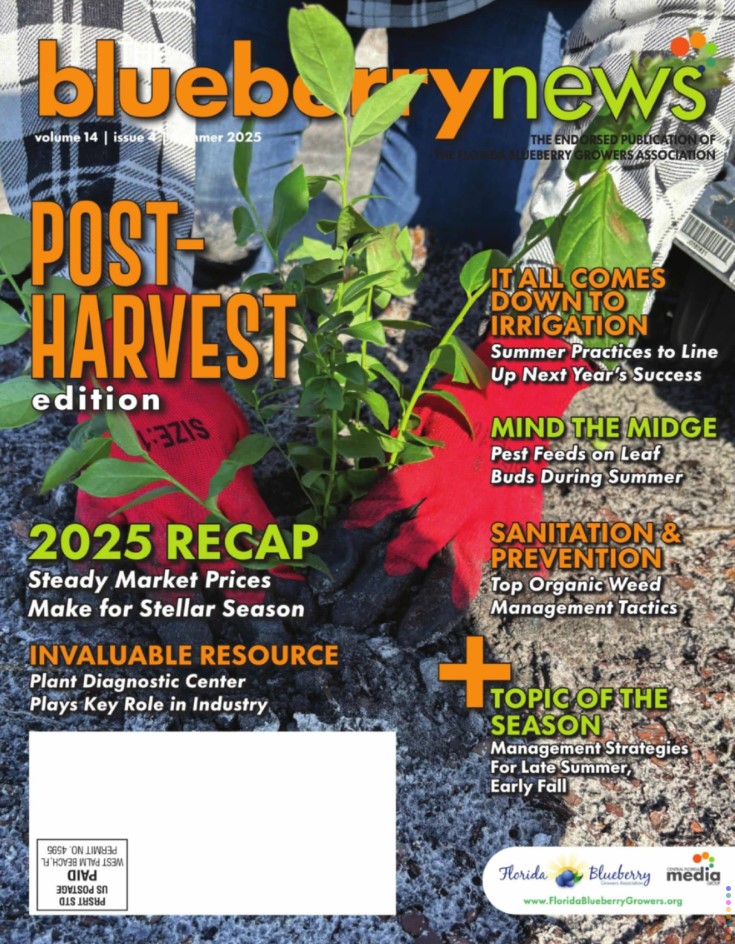Essential Preparations for Blueberry Freeze Protection
Freeze protection is an essential part of blueberry production in Florida, especially in the northern and central parts of the state. Although the past couple of winters have been warmer than usual, growers need to carefully monitor weather forecasts and plan accordingly to avoid possible crop damage. Freeze protection typically involves using overhead irrigation to reduce the impact of freezing temperatures on susceptible floral and fruit tissues.
Floral and Fruit Development Stage
Dormant buds are very cold hardy, and when buds remain tightly closed they are relatively resistant to freezing temperatures. However, as the buds open and floral and fruit tissues develop, they become more susceptible to freeze damage (Figures 1 and 2). The highest levels of risk for freeze damage are when petals fall from the blooms and green fruit develops. Growers should consider the stage of development of floral tissues and fruit when deciding on freeze protection measures.
Figure 1. Blueberry bud and bloom development stages
Figure 2. Freeze damage on blueberry floral bud and flowers.
Credits: E. Conlan, J. Williamson, UF
Weather conditions
Dew Point – This is the temperature at which water vapor condenses, and is a measure of water vapor content in the air. A low dew point (low water vapor levels) can increase evaporative cooling, and therefore lower temperatures. A high dew point (high water vapor levels) can decrease the rate of heat loss from the field, helping keep temperatures warmer.
Temperature – Many growers begin freeze protection at slightly above freezing if the wind is calm and the temperature is dropping and expected to drop below 32°F. This is because plant tissue (especially young berries) can be several degrees colder than the air temperature due to radiation cooling. As discussed earlier, critical temperatures for freeze protection vary with stage of bloom and fruit development.
Since dew point also has an impact on temperature, many growers use a wet bulb thermometer, which takes into account both air temperature and dew point. If a wet bulb thermometer is not available and air temperature is near freezing, an approximation can be calculated by subtracting one-third of the difference between air temperature and dew point from the air temperature. For example, if the air temperature is 34°F and the dew point is 25°F, the wet bulb temperature would be 31°F. Freeze protection using overhead irrigation should typically begin when the wet bulb temperature is at the critical temperature based on the stage of crop development.
Growers may want to consider starting freeze protection when the air temperature is 33°F - 35°F, to avoid unexpected temperature drops to damaging levels. This may be the case in situations including calm clear nights in lower-lying areas, where there is varying topography on the farm, to prevent the irrigation system from freezing prior to beginning protection, or to account for a brief reduction in temperature when overhead irrigation begins. Also, multiple stages of bloom and fruit development may be present at the same time, complicating the decision of when to begin freeze protection.
If it is sunny and calm on the morning following a freeze, the irrigation system can be turned off once icicles are falling rapidly from the bushes, and have been falling for at least 30 minutes. If it is windy and the dew point is 26°F or below, the system should remain on until most of the icicles have fallen. When the dew point is below 20°F, the irrigation system should remain on until the air temperature in the shade is 40°F.
Windspeed – Wind can increase evaporative cooling and interfere with the distribution of water from overhead irrigation, resulting in uneven protection. However, wind can help during a freeze event if overhead irrigation is not being used, since it can prevent cold air pockets from forming close to the ground under an inversion layer.
The amount of water (gallons per minute) needed for adequate freeze protection depends on air temperature, wind speed, dew point, and the design of the irrigation system. Table 1 presents some suggested overhead irrigation application rates based on temperature and wind speed. However, this table does not factor in dew point. When dew point (water vapor content) is very low, higher application rates than those listed in Table 1 are typically required.
The Florida Automated Weather Network (FAWN) (fawn.ifas.ufl.edu/) maintains a series of weather stations throughout Florida, and is a resource for current and historical weather conditions, including temperature, dew point, and wind speed. However, weather monitoring equipment located at the farm is the best indicator of local conditions. However, it may be helpful to understand how on-farm weather monitoring equipment correlates with nearby FAWN stations in the event of equipment malfunctions during freeze events.
Site Conditions – Site conditions can impact farm temperature during freeze events. For example, lower temperatures can occur in low-lying areas as cold air drains into those areas, resulting in differences in temperature across a farm during clear, cold nights.
Pine bark mulch and dry soil can interfere with heat transfer from the ground, resulting in lower air temperatures. Dry soil can also lower air temperature due to its inability to replace water vapor lost through frost formation. In certain situations, it may be helpful to irrigate fields the afternoon before an expected freeze to help raise soil moisture and field temperatures.
Irrigation System Check and Repair
Take the time now to examine your overhead irrigation system to make sure everything is in working order before the first freeze event, and make any necessary repairs. This may include –
-
Well heads, pumps, and electrical systems
-
Sprinkler heads, pipes, and filters
-
Water inlets for surface water sources
-
Thermometers and other monitoring systems
-
Well pump fuel tank levels
-
Operate the overhead irrigation system for a final check of the system and make any repairs to ensure it is working properly
For additional details on freeze protection for blueberries in Florida, see UF EDIS Publications HS968, Protecting Blueberries from Freezes in Florida (https://edis.ifas.ufl.edu/pdffiles/HS/HS21600.pdf) and FE979, Improving the Precision of Blueberry Frost Protection Irrigation (edis.ifas.ufl.edu/hs216).
Table 1.
Suggested overhead irrigation application rates for cold protection of blueberries under different wind and temperature conditions1
|
Minimum temperature expected |
Wind speed (miles per hour) |
|||
|
0–1 |
2–4 |
5–8 |
10–12 |
|
|
|
Application rate (inches per hour) |
|||
|
27°F |
0.10 |
0.10 |
0.22 |
0.22 |
|
26°F |
0.10 |
0.10 |
0.22 |
0.2 |
|
24°F |
0.10 |
0.16 |
0.3 |
0.4 |
|
22°F |
0.12 |
0.24 |
0.5 |
0.6 |
|
20°F |
0.16 |
0.3 |
0.6 |
0.8 |
|
18°F |
0.20 |
0.4 |
0.7 |
1.0 |
|
15°F |
0.26 |
0.5 |
0.9 |
--- |
|
1Dry air accompanied by wind requires higher application rates than indicated for a given temperature/wind speed combination. From Gerber and Martsolf (1965). 2Higher application rates than originally suggested by Gerber and Martsolf (1965) due to possible evaporative cooling during windy conditions. |
||||
by DOUG PHILLIPS, BLUEBERRY EXTENSION COORDINATOR, UF
& JEFF WILLIAMSON, PROFESSOR, HORTICULTURAL SCIENCES DEPARTMENT, UF





